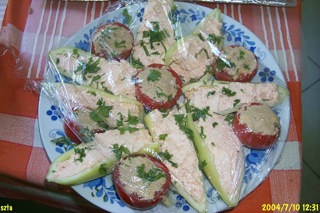HUNGARY
Contributors: Szabó Magda T., Szabó Attila T. and Antal Lászlo
Introduction: *
In Hungary, Advent is traditionally a time of fasting and this includes Christmas Eve, but in a wider sense the Feasts (az Ünnepek) extend up to 6th January. Of these 'Holy Days' (Szent Ünnepek) the evening of the 24th (Christmas Eve) is the most important, especially for the families with children who gather all generations together around the Christmas tree covered with ornaments, sparklers and lit candles. The second and third days of Christmas are generally more meditative. The 31st December (New Year's Eve) is mostly a social event with friends and families gathering together mostly on a generation basis. It is dedicated to fun, eating and drinking. The New Year's roast suckling pig is still a symbolic dish for this occasion.
There are differences in customs according to religious denomination, i.e. whether Catholic or Protestant (Evangelical Lutheranians, Reformed Calvinists, Unitarians, etc.). The Catholics eat much more fish than the Protestants, etc. There are also regional differences in different parts of Hungary, as well as among the large Hungarian ethnic groups which after the 1920 peace treaties became citizens of Czechoslovakia, Ukraine, Romania, Yugoslavia or even Austria.
As in most European countries customs have changed and old traditions not necessarily retained. However, carp on Christmas Eve and the walnut or poppy-seed roll on Christmas Day are traditions that have been retained in many families. There is also a wider range of dishes which families might choose to serve on Christmas Day itself. Therefore, recipes for a variety of different dishes are given below but they are not all eaten only as traditional Christmas foods. In order to compile this collection of Christmas recipes, as used in our family and generally by the Hungarians, Lendvai (2007)** [English translation: From the Kitchen Window] was referred to as a starting point, but the recipes were adapted as prepared in our family.
Photograph (c)2008 Szabó, Attila T.
A plate with tomatoes filled with vinetta (see below) and
pale green peppers filled with Körözött
(a spicy cream cheese mixed with raw onion and butter)
* (c)Copyright 2008 Szabó Attila T., Helen Macbeth. Permission is hereby granted to reproduce and distribute copies of this Introduction to recipes for Hungary solely for the purposes of non-profit domestic use or non-profit educational purposes in either case provided that copies are distributed at or below cost and that the author's source and copyright notice are included on each copy.
** Lendvai, I (2007) A konyha ablakából, Jokerex Kiadó, Budapest
